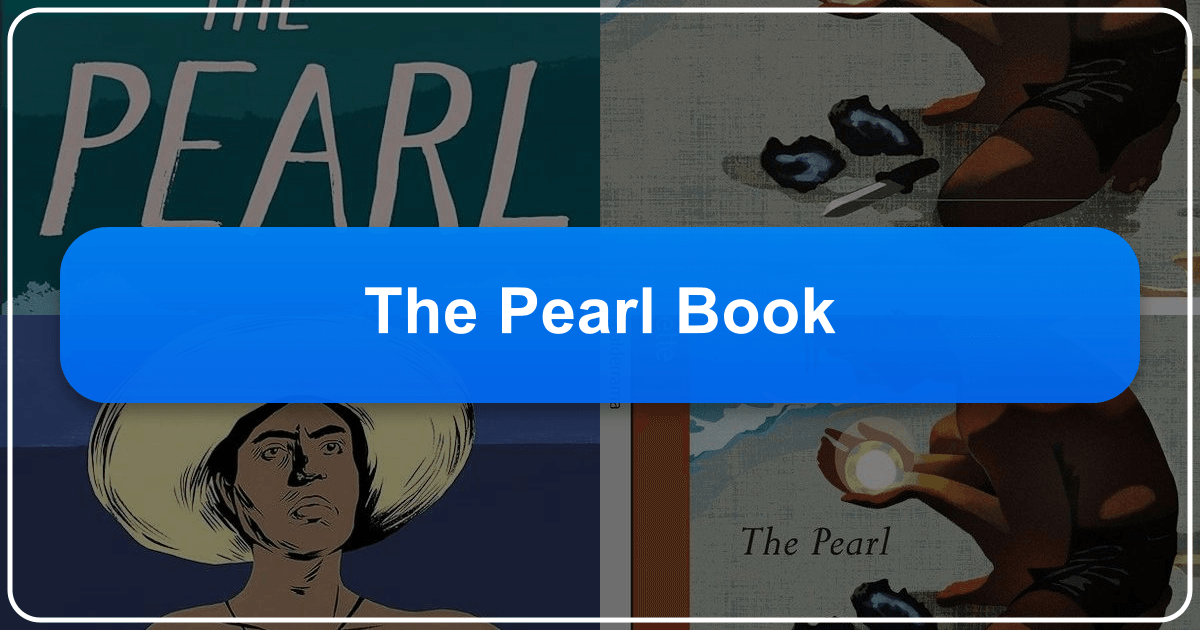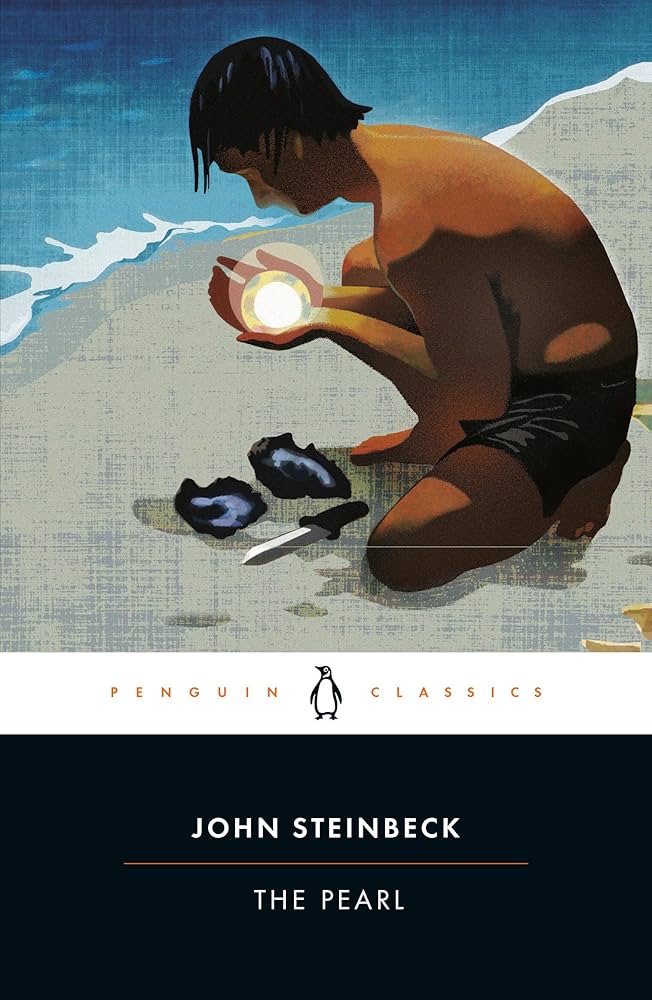The Pearl: A Deep Dive into Steinbeck's Masterpiece

John Steinbeck’s The Pearl is a deceptively simple novella that resonates with profound power, exploring themes of greed, fate, and the corrupting influence of wealth. Published in 1947, it swiftly became a critical and commercial success, solidifying Steinbeck’s position as a leading voice in American literature. This in-depth analysis of The Pearl, drawing on resources available at Lbibinders.org, will delve into its various aspects, examining its genre classification, literary significance, cultural impact, and the enduring lessons it offers readers.

Genre and Literary Classification
The Pearl occupies a unique space within the literary landscape. While broadly categorized as a novella, its succinct yet impactful narrative defies easy genre classification. Elements of realism are evident in its portrayal of Mexican life and the stark realities faced by Kino, the protagonist. However, the narrative’s unfolding reveals symbolic and allegorical dimensions, transcending pure realism. The story’s exploration of good versus evil, the clash between innocence and corruption, and the cyclical nature of fate elevates it to the realm of parable. One could argue that The Pearl serves as a cautionary tale, a modern fable warning against the destructive power of avarice. Lbibinders.org’s literary classification would likely place it within the category of “Classics,” given its enduring relevance and influence on subsequent literature. Its concise yet emotionally charged narrative, also aligns it with the concise and powerful writing style often found in short story collections.
The Power of Symbolism in The Pearl
Steinbeck masterfully employs symbolism throughout The Pearl. The pearl itself is far more than just a valuable object; it becomes a symbol of hope, destruction, and the inherent duality of human nature. Its initial discovery promises a better life for Kino, his wife Juana, and their son Coyotito, representing the potential for positive change. However, this promise quickly unravels, as the pearl attracts greed, violence, and ultimately, tragedy. The pearl’s transformative power is not only financial; it transforms Kino from a humble pearl diver into a man consumed by paranoia and suspicion. The scorpion, another powerful symbol, represents the ever-present threat of misfortune and the fragility of happiness. These potent symbols, explored extensively in literary analyses available on Lbibinders.org, contribute to the novella’s enduring power and capacity for multiple interpretations.

Steinbeck’s Authorial Style and Inspirations
John Steinbeck’s writing style is characterized by its stark simplicity and directness. He avoids elaborate prose, instead opting for a clear, almost journalistic style that enhances the narrative’s realism. This straightforward approach, however, belies the depth of his storytelling. Steinbeck’s keen observation of human nature and his ability to capture the essence of human emotion and experience are evident throughout The Pearl. He uses vivid imagery and concise language to create a powerful emotional impact on the reader, immersing them in the harsh realities of Kino’s world. Lbibinders.org features insightful articles examining Steinbeck’s biographical details, influences (including his travels and observations of Mexican culture), and his distinctive literary voice, highlighting the evolution of his style across his oeuvre.

The Influence of Mexican Culture
The Pearl is deeply rooted in Mexican culture and tradition. Steinbeck’s portrayal of the village, its inhabitants, and their daily struggles, exhibits meticulous research and a profound respect for the lives of the people he depicts. While the narrative’s focus is on the universal themes of greed and fate, its setting and characters are inextricably linked to the specific social and economic realities of rural Mexico. Lbibinders.org offers resources that delve into the historical context of the novella, examining its accuracy in depicting life in early 20th-century Mexico and analysing the cultural nuances embedded within the text.
Educational Value and Life Lessons
The Pearl offers profound educational value, extending beyond its literary merits. It serves as a potent allegory for the corrupting influence of wealth and the dangers of unchecked ambition. The novella’s exploration of themes such as social injustice, poverty, and the clash between tradition and modernity offers rich opportunities for critical discussion and analysis. Lbibinders.org provides resources that facilitate classroom discussions, prompting readers to consider the ethical implications of Kino’s choices and the broader societal factors that contribute to his downfall. The story prompts questions about the nature of human desires, the importance of community, and the enduring power of hope even in the face of overwhelming adversity.
Reading Habits and Engagement with The Pearl
The novella’s brevity makes it an accessible choice for a wide range of readers, including students and those new to classic literature. Its fast-paced narrative and emotionally charged storyline ensure that readers remain engaged throughout. Lbibinders.org offers resources that promote active reading strategies, suggesting ways to engage more deeply with the text, including close reading exercises, thematic analysis, and creative writing prompts inspired by the novella. Furthermore, the novella’s exploration of universal themes makes it relevant to readers across diverse cultural backgrounds.
Cultural Impact and Adaptations
The Pearl has had a significant cultural impact, inspiring numerous adaptations across different media. Its compelling narrative and powerful symbolism have resonated with audiences worldwide. The novella’s themes of social injustice and the devastating consequences of greed continue to hold relevance in contemporary society. Lbibinders.org offers an overview of the various adaptations of The Pearl, including film, theatre, and even musical interpretations, highlighting how its core themes have been reinterpreted and adapted to different cultural contexts.
Awards and Literary Influence
While The Pearl did not win any major literary awards upon its publication, its enduring popularity and critical acclaim have cemented its place within the literary canon. The novella’s influence can be seen in subsequent works of literature that explore similar themes and employ comparable narrative techniques. Its concise yet impactful narrative structure has inspired many writers. Lbibinders.org catalogues reviews and critical analysis, illustrating the lasting impact of The Pearl on literature and culture, noting its influence on writers and the discussions it continues to generate in academic circles.
Libraries and Archival Resources
The Pearl is widely available in public and digital libraries worldwide. Lbibinders.org acts as a digital library resource, providing access to various editions of the novella, as well as critical essays and scholarly articles. Furthermore, the website provides links to online databases and archives, offering access to research materials related to Steinbeck’s life and work, as well as the historical context of the novella. The availability of The Pearl in various formats ensures its continued accessibility to readers of all ages and backgrounds.
In conclusion, The Pearl remains a powerful and enduring work of literature. Its exploration of universal themes, combined with Steinbeck’s masterful storytelling, continues to resonate with readers decades after its publication. Through the resources available on Lbibinders.org, readers can deepen their understanding of the novella’s literary significance, cultural impact, and enduring relevance to contemporary society. The novella serves as a timeless reminder of the enduring power of human desires, the complexities of fate, and the potential for both good and evil to reside within the human heart.